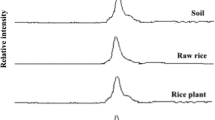Abstract
In the environment, plants and animals in vivo, pesticides can be degraded or metabolized to form transformation products (TPs) or metabolites, which are even more toxic than parent pesticides. Hence, it was necessary to evaluate residue and risk of pesticides and their TPs (or metabolites). Here, a rapid, simple, and reliable method using QuEChERS and LC-MS/MS had been developed for simultaneous analysis of prothioconazole and its toxic metabolite, prothioconazole-desthio, in soil, wheat plant, straw, and grain. The average recoveries of prothioconazole and prothioconazole-desthio in four matrices ranged from 86 to 108% with relative standard deviations (RSDs) of 0.53–11.87% at three spiking levels. The method was successfully applied to investigate the dissipation and terminal residues of the two compounds in wheat field. It was shown that prothioconazole was rapidly degraded to prothioconazole-desthio, with half-lives below 5.82 days. Prothioconazole-desthio was slowly dissipated in soil and plant. The terminal residues of prothioconazole in wheat grain with a pre-harvest interval (PHI) of 21 or 28 days were below the maximum residue limits (MRLs) (0.1 mg/kg, Codex Alimentarius Commission (CAC)). We also evaluated the intake risk of prothioconazole-desthio residues in wheat grain in China. For long-term intake assessment, the hazard quotients (HQ) ranged from 1.30 to 5.95%. For short-term intake assessment, the acute hazard indexes (aHI) ranged from 1.94 to 18.2%. It indicated that the intake risk of prothioconazole-desthio in wheat consumption was acceptable. Thus, the prothioconazole application on wheat with the scientific practices would not pose public health risk.



Similar content being viewed by others
References
Audenaert, K., Callewaert, E., Höfte, M., Saeger, S. D., & Haesaert, G. (2010). Hydrogen peroxide induced by the fungicide prothioconazole triggers deoxynivalenol (DON) production by fusarium graminearum. BMC Microbiology, 10(6), 3–21.
Australian Pesticides and Veterinary Medicines Authority (APVMA). (2007). Evaluation of the new active prothioconazole in the product redigo fungicidal seed treatment. Canberra: Australian Pesticides and Veterinary Medicines Authority.
Chen, X., Dong, B., Zhong, M., & Hu, J. (2015). Dissipation kinetics and residues of amidosulfuron and mcpa in wheat ecosystems based on a modified quechers and low-temperature cleanup method using the RRLC-QqQ-MS/MS technique. Analytical Methods, 7(24), 10299–10305.
Codex Alimentarius Commission (CAC) (2016). Pesticide residues in food and feed. http://www.fao.org/faowho-codexalimentarius/standards/pestres/en/. Site accessed on 25th October 2016.
Edwards, S. G., & Godley, N. P. (2010). Reduction of fusarium head blight and deoxynivalenol in wheat with early fungicide applications of prothioconazole. Food Additives and Contaminants-Part A Chemistry, Analysis, Control, Exposure and Risk Assessment, 27(5), 629–635.
European Commission (2017). EU pesticides database. http://ec.europa.eu/food/plant/pesticides/eu-pesticidesdatabase/public/?event=activesubstance.detail&language=EN&selectedID=1783. Site accessed on 18th March 2017.
European Food Safety Authority (EFSA) (2010). Reasoned opinion of efsa: modification of the existing MRLs for prothioconazole in various root vegetables. Efsa Journal, 8(7), n/a-n/a.
Food and Agriculture Organization of the United Nations (FAO) (2008). List of Pesticides evaluated by JMPR and JMPS-P. http://www.fao.org/agriculture/crops/core-themes/theme/pests/ lpe/ lpe-p /en.
Ghani, S. B. A., & Abdallah, O. I. (2016). Method validation and dissipation dynamics of chlorfenapyr in squash and okra. Food Chemistry, 194, 516–521.
Huang, X. Q., & Röder, M. S. (2004). Molecular mapping of powdery mildew resistance genes in wheat: a review. Euphytica, 137(2), 203–223.
Khan, Z. I., Ahmad, K., Rehman, S., Siddique, S., Bashir, H., Zafar, A., et al. (2016). Health risk assessment of heavy metals in wheat using different water qualities: implication for human health. Environmental Science and Pollution Research International. doi:10.1007/s11356-016-7865-9.
Liang, H., Li, L., Qiu, J., Li, W., Yang, S., Zhou, Z., et al. (2013). Stereoselective transformation of triadimefon to metabolite triadimenol in wheat and soil under field conditions. Journal of Hazardous Materials, 260(18), 929–936.
Malhat, F., Badawy, H. M. A., Barakat, D. A., & Saber, A. N. (2014). Residues, dissipation and safety evaluation of chromafenozide in strawberry under open field conditions. Food Chemistry, 152(6), 18–22.
Parker, J. E., Warrilow, A. G. S., Cools, H. J., Fraaije, B. A., Lucas, J. A., Rigdova, K., Griffiths, W. J., Kelly, D. E., & Kelly, S. L. (2013). Mechanism of binding of prothioconazole to CYP51 differs from that of other azole antifungals. Applied & Environmental Microbiology Aem, 79, 1639–1645.
Souverain, S., Rudaz, S., & Veuthey, J. L. (2004). Matrix effect in LC-ESI-MS and LC-APCI-MS with off-line and on-line extraction procedures. Journal of Chromatography A, 1058(1–2), 61–66.
Wang, L. D. (2005). Survey of nutrition and health status of Chinese residents. Beijing: People’s Health Publishing House.
World Health Organization (WHO) (2008). Pesticide residues in food–2008: Part II–Toxicological evaluations. Rome, Italy: joint FAO/WHO meeting on pesticide residues.
World Health Organization (WHO) (2012). GEMS/Food consumption database. http://www.who.int/nutrition/landscape_analysis/nlis_gem_food/en/.
Xavier, S. A., Canteri, M. G., Barros, D. C. M., & Godoy, C. V. (2013). Sensitivity of corynesporacassiicola from soybean to carbendazim and prothioconazole. Tropical Plant Pathology, 38(5), 431–435.
Zhou, F., Dai, L., Wei, S., Cheng, G., & Li, L. (2015). Toxicokinetics and tissue distribution of prothioconazole in male adult Sprague-Dawley rats following a single oral administration. Xenobiotica, 45(5), 1–6.
Acknowledgments
This work was supported by the Natural Science Foundation of Beijing under Grant [number 8162029].
Author information
Authors and Affiliations
Corresponding author
Electronic supplementary material
Supplementary Table S1
(DOCX 12 kb)
Supplementary Table S2
(DOCX 14 kb)
Supplementary Table S3
(DOCX 14 kb)
Supplementary Table S4
(DOCX 12 kb)
Supplementary Table S5
(DOCX 12 kb)
Supplementary Table S6
(DOCX 11 kb)
Supplementary Table S7
(DOCX 12 kb)
Rights and permissions
About this article
Cite this article
Lin, H., Dong, B. & Hu, J. Residue and intake risk assessment of prothioconazole and its metabolite prothioconazole-desthio in wheat field. Environ Monit Assess 189, 236 (2017). https://doi.org/10.1007/s10661-017-5943-1
Received:
Accepted:
Published:
DOI: https://doi.org/10.1007/s10661-017-5943-1




